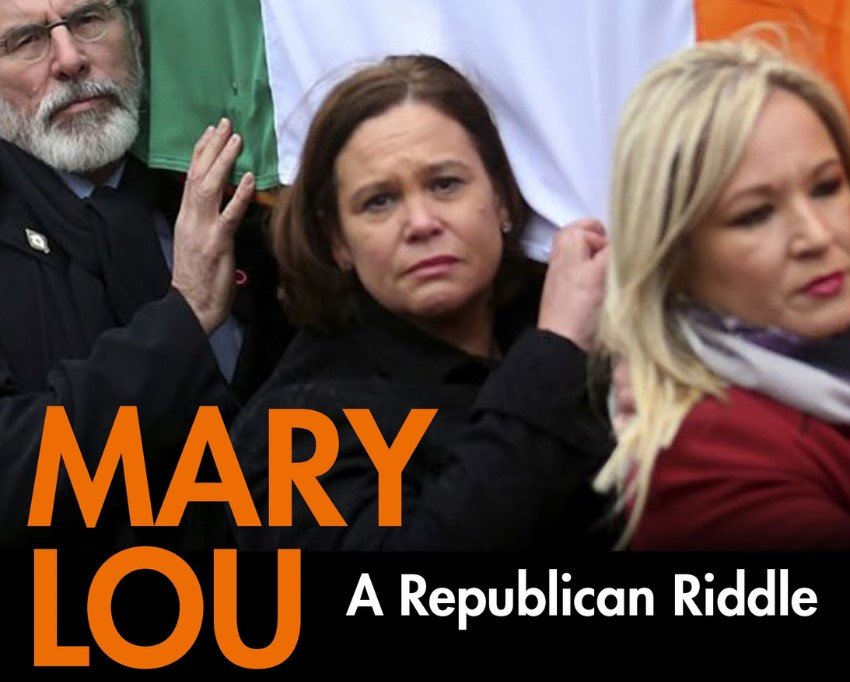
Mary Lou McDonald, A Republican Riddle
By Shane Ross
Atlantic Books, 2022
Mary Lou McDonald, A Republican Riddle is no hagiography, nor is it a glib hatchet-job. Rather, Shane Ross’s new book about the current President of Sinn Fein and presumptive future prime minister of Ireland is an intriguing combination of admiration and dread. Ross is both fascinated by and fearful of his biographical subject.
When I started reading this book I was skeptical about the author’s credentials. A journalist, stockbroker, and elected Irish parliamentary politician, Ross is neither a socialist nor an Irish Republican. He is from a protestant Dublin background, attended private school in England and then Dublin’s prestigious Trinity College. He began his political career in the conservative Fine Gael party, later taking office as an Independent member of the Irish Parliament, the Dail.
Ross makes no secret of his contempt for the modern (Provisional) Irish Republican Army (IRA) and its violent guerrilla-war campaign of the 1970s‒90s, which ended in 1998 with the Good Friday Agreement. Ross calls IRA actions “terrorism” and he describes in detail some of the most horrific atrocities attributed to it, while barely mentioning parallel British and Loyalist atrocities. Nor does Ross give any context or motivation for the IRA’s actions.
Ross clearly despises Gerry Adams, the previous Sinn Fein party president and former member of the Dail. Adams denies having been an IRA member but is widely presumed to have been an IRA commander, if perhaps from the position of a civilian leader. (United States President Joe Biden is not a member of the US military, though he is their Commander in Chief.) Ross is disingenuous in downplaying Adams’s crucial role in the ending of the IRA war campaign. He refers to Adams as a “godfather” emitting a “whiff of sulphur”, and as a “dour”, menacing, nearly humourless personality. (Having met Adams myself, I would beg to differ with this characterisation). Ross snidely implies that Adams still “pulls the strings” controlling McDonald and her career.
One might suppose that Ross would be too hostile and biased a reporter, given that McDonald is Adams’ protégé and now leads Sinn Fein. The party includes many IRA war veterans, supported the IRA, still celebrates its long “armed struggle” and glorifies its “patriot dead”, while at the same time adhering to the enduring “peace process”.
However, Ross’s yawning political (and moral) distance from McDonald and her party gives him a perspective that a more sympathetic biographer might have lacked. His at times grudging — and sometimes amused — admiration for McDonald’s skills and determination often outshines his ire in this perplexing and at times amusing 400-page book.
The book is very detailed and Ross tends to repeat himself. For readers outside Ireland, his parade of arcane political inside knowledge (and Gaelic names) may be daunting, Yet, for a reader with some previous grasp of recent Irish history, the book is of value and worth the effort.
McDonald was born on May 1, 1969 and is a personable and witty woman now in her early 50s, Ross writes. She grew up in Dublin in a troubled but not abusive or violent family during a period of social change in Eire (the “southern” Republic of Ireland) and of violent near civil-war turmoil (“The Troubles”) in the six north-eastern counties known as Northern Ireland, which remain under British rule.
McDonald attended private schools, then Trinity College and had a hesitant career start before plunging into politics with the nominally-republican but thoroughly establishment Fianna Fail party.
Meanwhile, in the north of Ireland, civil rights demonstrations gave way to riots and a long-drawn-out asymmetric war fought between Irish Republican forces and the British Army with their Loyalist militia allies. Out of the famous hunger strike campaign of 1981 emerged the Sinn Fein party as a real, electable political entity, no longer simply the legal mouthpiece of the IRA.
McDonald, disillusioned with the stodgy corruption of Fianna Fail, left that party to join Sinn Fein where her talents were welcomed and put to the fore in a series of electoral campaigns with McDonald as candidate. She was elected to the European Parliament in Brussels and, eventually, to the Irish Dail. Along the way, her political rise was encouraged and facilitated by Adams, the unchallenged leader of the strictly disciplined, moderately leftist/populist Sinn Fein.
Although she claims Irish Republican family and personal sympathies, McDonald never joined the IRA. Therefore she had to work to gain enthusiastic support from Sinn Fein’s northern corps of IRA veterans. She did win that support, to a degree.
Now, with Sinn Fein enjoying unprecedented popularity and electoral support both north and south of the partition border, McDonald — who has dedicated her political life to the quest for Irish national unity — appears poised to assume the role of Taoiseach (Prime Minister) in the near future. What sort of leadership will McDonald and her triumphant Sinn Fein give to Ireland? That is the question (or “riddle”) Ross’s book raises, but does not answer. Ross indicates he does plan to write a sequel or two.
With some reluctance, I recommend this book. It is valuable, if slanted. One hopes that in coming years there will be other books about the rise of contemporary Sinn Fein and its leader.